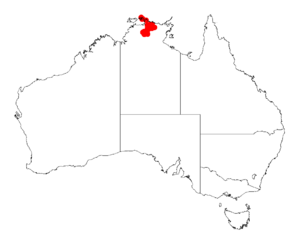Acacia convallium facts for kids
Quick facts for kids Acacia convallium |
|
|---|---|
| Scientific classification | |
| Genus: |
Acacia
|
| Species: |
convallium
|
 |
|
| Occurrence data from AVH | |
Acacia convallium is a type of tree that belongs to the Acacia family. It is a special kind of plant because it grows naturally only in a specific part of northern Australia. This means it is endemic to that area.
What it Looks Like
This tree usually grows to be about 6 meters (about 20 feet) tall. Its small branches are round and feel fuzzy because they are covered in short hairs.
Like most Acacia trees, it doesn't have regular leaves. Instead, it has what are called phyllodes. These phyllodes are always green and can be shaped like an oval or a sickle (a curved blade). They are usually between 9 and 17.5 centimeters (about 3.5 to 7 inches) long and 1.2 to 4 centimeters (about 0.5 to 1.5 inches) wide. Each phyllode has two to four main lines, or nerves, running along it. They also have a few scattered hairs, sometimes just near the bottom.
The tree blooms between April and May. It produces groups of four to six round flower-heads. Each flower-head has about 30 creamy to golden yellow flowers.
How it Got its Name
A botanist named Leslie Pedley first officially described this tree in 1999. He wrote about it in a scientific paper called Notes on Acacia (Leguminosae: Mimosoideae) chiefly from northern Australia, which was published in the journal Austrobaileya.
Later, in 2003, Pedley changed its name to Racosperma convallium. But then, in 2006, it was moved back to the Acacia group, which is where it is known today.
Where it Grows
Acacia convallium is found only in a small part of the Northern Territory in northern Australia. This area is often called the "Top End." You can find it along the Coburg Peninsula and near the upper parts of the Alligator and Liverpool Rivers.
It often grows in rocky areas like gorges or on sandstone cliffs. It prefers sandy soils, whether they are thin or deep.

